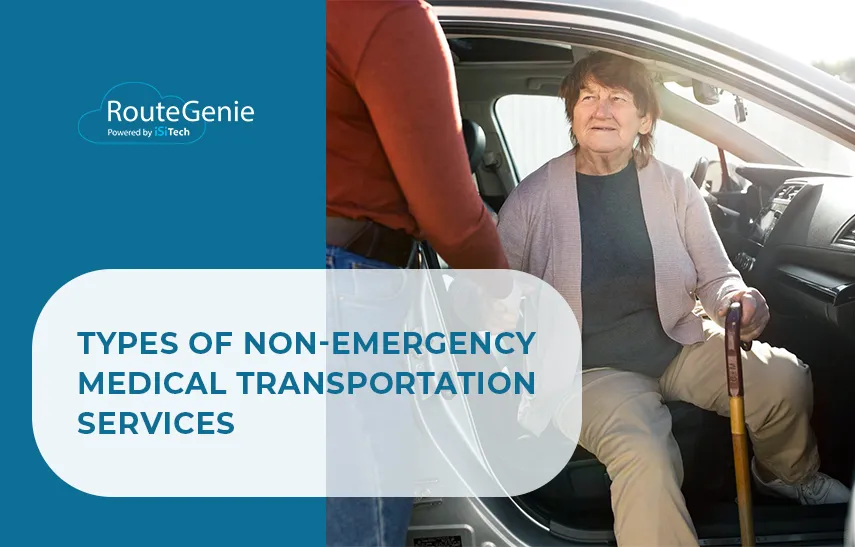Types of Non-Emergency Medical Transportation Services

Non-emergency medical transportation (NEMT) has been around for decades, but in some ways, it seems like the industry is still in its infancy.
It started because beneficiaries of Medicaid—the government health insurance system passed into law in 1965—were clamoring for better transportation coverage. They were low-income people, pregnant women, the elderly, and persons with disabilities and other medical needs that required specialized vehicles and transport services.
For many years, those with special medical needs who were not Medicaid beneficiaries depended on private vehicles to go to and from healthcare facilities for their checkups and medical tests or procedures. Some had to use taxis and public transportation, which is incredibly difficult for many.
Eventually, entrepreneurs realized there is potential in starting an NEMT business that is not exclusive to Medicaid use.
In this article, we will discuss the different non-emergency medical transportation services for elderly and disabled people and benefits from them.
Contents:
What is Non-Emergency Medical Transportation?
NEMT caters to passengers with special healthcare needs who are not experiencing medical emergencies. They include people in wheelchairs or those who need medical equipment like oxygen tanks and stretchers.
Non-emergency medical transportation vehicles are equipped with the necessary equipment to meet passengers’ specialized needs and ferry passengers safely and securely.
The following are some special features within NEMT vehicles:
- Wheelchair ramps
- Handrails
- Ergonomically designed seats for comfort
- Large passenger space to accommodate various medical equipment
Another important aspect of NEMT service is that the drivers must have healthcare training. They are educated on how to transport and help patients with special needs so they can assist all passengers from pickup to drop off.
How Does it Work?
 Specialized transportation for individuals with disabilities primarily benefits the elderly and people with disabilities. After all, they need regular checkups to monitor their health and refill their medications. Their physician will schedule appointments, and they will need to find their way to the medical facility.
Specialized transportation for individuals with disabilities primarily benefits the elderly and people with disabilities. After all, they need regular checkups to monitor their health and refill their medications. Their physician will schedule appointments, and they will need to find their way to the medical facility.
When the appointment date is set up, the patient can easily call for an NEMT service through the NEMT passenger app or directly with the transport company. The NEMT provider will schedule their pickup and designate a driver and vehicle for the appointment.
It is best for those with special medical needs to partner with NEMT providers rather than a taxi or public transport. These traditional vehicles are not equipped with the right features to accommodate older adults on walkers or people who need wheelchairs or stretchers.
Perhaps some of the patients who have been living with their medical situation for so long had customized their private vehicles for their transportation needs. But if there is no one to drive them, they can’t get to their appointments.
The NEMT business grows to helps people with medical needs and the elderly become more independent. Instead of waiting for family or friends to be available to take them to their appointments, they can schedule the trip themselves.
Who Pays for Non-Emergency Medical Transportation?
Many who use NEMT are Medicaid beneficiaries. In this case, the NEMT trip is paid for by the government. NEMT is part of the coverage of an individual’s Medicaid plans. Medicaid beneficiaries usually get reimbursements when using NEMT service.
Some NEMT clients are private pay patients. These are passengers who need specialized transportation but are not qualified for Medicaid coverage, which prioritizes low-income people.
Charges for NEMT vary depending on the type of transportation, area, passenger’s specific needs, and the nature of their trip. Patients who need the most basic NEMT vehicles will need to pay less than those who require specialized transportation and equipment.
And as with any transport service, distance is one of the biggest factors that will determine cost.
This is also why NEMT services need software to quickly determine the best routes, dispatch the proper vehicles, and accurately calculate bills for all passengers. RouteGenie is an excellent all-in-one software that will help make NEMT operations seamless and easy.
Types of Non-Emergency Medical Services
Every passenger has different needs, which would merit different types of emergency medical services and non-emergency medical services.
For emergency cases, patients need a more complex medical vehicle and comprehensive care to transport them to the emergency room. The situation would call for an ambulance and highly trained medical personnel.
What Makes Ambulance and Medical Vehicle Services Different Than NEMT?
 An ambulance is medically equipped to treat patients in emergencies. It has the space to accommodate a gurney and various medical devices to support the patient’s breathing and monitor their vital signs as they make their way to the emergency room.
An ambulance is medically equipped to treat patients in emergencies. It has the space to accommodate a gurney and various medical devices to support the patient’s breathing and monitor their vital signs as they make their way to the emergency room.
More importantly, the ambulance is manned by a complete team of emergency medical technicians (EMTs) or paramedics. EMTs treat the patient and deliver the emergency care they need while waiting for more intensive treatment when they arrive in the hospital.
The ambulance contains several types of medical equipment because there is no way to predict what emergency they will deal with on any given day.
In contrast, NEMT services can take on various forms. All trips are booked in advance, and there is a set time and place for pickup and dropoff. More importantly, dispatchers and drivers know exactly what their passengers will need for a safe trip.
NEMT services can take on different forms, too:
1. Ambulatory Transportation
Ambulatory transportation is the most basic type of NEMT vehicle. It is for passengers who don’t need any type of medical equipment or device and are largely mobile on their own. For example, senior citizens who don’t need wheelchairs or stretchers may only need comfortable seating.
The driver can easily assist the patient to and from the vehicle, which could simply be a customized sedan with spacious seating at the back. Even a person who uses a cane or collapsible walker can request an ambulatory transport service for their appointment.
2. Wheelchair Transportation
People who use wheelchairs may call for wheelchair transportation designed to accommodate such equipment. Larger vehicles, like vans, are required for this. These vehicles have lifts to get the wheelchair in and out.
Some NEMT companies also provide wheelchairs for rent for patients who need them. Drivers of wheelchair transportation services are usually trained to provide CPR (cardiopulmonary resuscitation) and other basic medical assistance.
It has to be noted that people who use this type of service don’t require emergency care.
3. Stretcher Medical Transportation
Some of the most challenging patients to transport are bedridden individuals that can no longer sit upright. But they are the ones who need regular checkups the most, so they will need stretcher medical transportation. In many cases, the NEMT provider will also provide the stretcher.
It can be difficult for one person to operate a stretcher. NEMT drivers are often not alone in this type of transport, and they will have a partner on the road to help get the patient and stretcher on and off the medical van.
4. Courier Service
NEMT companies can also provide medical courier transportation services. These are for the delivery of human blood, organs, and others from one facility to another. However, private pay patients may also hire this type of service to deliver oxygen and other medical devices necessary for a patient staying at home.
All drivers involved in medical courier work must adhere to the strictest standards set by the Health Insurance Portability and Accountability Act.
Conclusion
NEMT is now a multi-billion-dollar industry that is continually growing. Its success stems from the needs of senior citizens and persons with disabilities that are currently being met.
But to succeed as an NEMT provider, you will need robust software that will make scheduling appointments seamless and provide the most practical and sensible routes for your drivers. RouteGenie has all of these features, plus quick dispatching, billing, and even HR tools.
Get a professional RouteGenie demo here.
About the author

As RouteGenie's Marketing Director, Yurii gained deep knowledge in the NEMT industry. He is an expert in marketing, utilizing all marketing channels to build RouteGenie's brand and to make sure NEMT providers have access to powerful NEMT software that can boost their growth. Yurii shares his knowledge by writing content on topics related to marketing, and the healthcare industry: medical transportation, home care, and medical billing.
The author assumes no responsibility or liability for any errors or omissions in the content of this site. The information contained in this site is provided on an "as is" basis with no guarantees of completeness, accuracy, usefulness or timeliness.